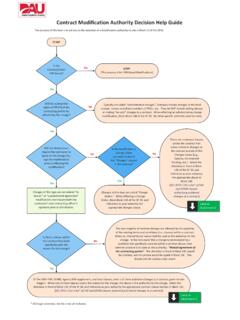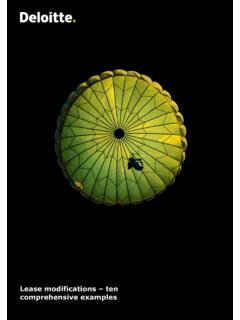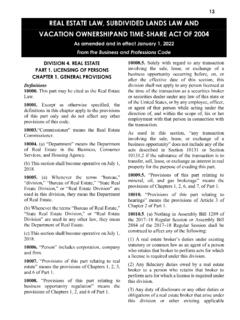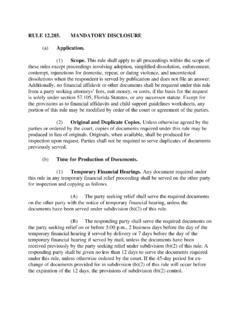Transcription of Short-term leases - Deloitte
1 I Short-term leases i Foreword IFRS 16 leases became effective for accounting periods beginning on or after 1 January 2019. The standard includes an important practical expedient for leases with a lease term of twelve months or less: Short-term leases . This expedient enables entities to simply expense lease payments over the lease term and avoid the more complex accounting of recognising a right-of-use asset and a corresponding liability on the balance sheet. On initial application, many entities have taken advantage of this practical expedient; however, it is important both from an accounting system s perspective and for those involved in negotiating and approving leases to understand the potential accounting consequences of subsequent amendments or renewals of these leases . This publication, in line with previous guidance in this series, provides a step-by-step explanation of the accounting implications of the various subsequent changes that might impact a Short-term lease s classification using practical and easy to follow examples.
2 Stephen Taylor Partner Emeritus September 2019 ii Acknowledgements The author would like to thank the following people from Deloitte Asia Pacific for their unwavering support in reviewing the China Firm s IFRS 16 leases series of publications. Alison White Partner Sydney Gordon Lee Partner Hong Kong Stephen Taylor Partner Emeritus Hong Kong iii Other IFRS 16 leases publications In reverse chronological order: lease modifications ten comprehensive examples (July 2019) lease modifications extending the lease term (May 2019) A guide to the incremental borrowing rate (September 2017) leases : A guide to IFRS 16 (June 2016) iv Contents Foreword .. i Acknowledgements .. ii Other IFRS 16 leases publications .. iii Contents .. iv Introduction .. 1 The life of a Short-term lease .. 2 The lease term .. 2 Some basics .. 3 modification of a Short-term lease .. 4 Exercising an extension option .. 11 Impact of termination options.
3 14 Appendix I relevant IFRS 16 guidance .. 23 Appendix II relevant Deloitte guidance .. 27 Contacts .. 28 1 Introduction A recipe for Short-term leases or not? IFRS 16 leases defines a Short-term lease as one that has a lease term of 12 months or less without any purchase options. IFRS 16 contains a practical expedient that allows a lessee the choice of keeping Short-term leases off-balance sheet . Many entities are taking advantage of this practical expedient; however, entities may tend to have a once Short-term , always Short-term mentality. In other words, once a lease is classified as a Short-term lease , it tends to fall off management s radar and subsequent changes thereto that might result in its failing the Short-term lease definition are often overlooked. This publication highlights these subsequent changes, which can be broadly categorised as follows: 1) modification of a Short-term lease : see examples 1 to 4 (see also related publications below); 2) Exercising an extension option: see example 5; and 3) Impact of termination options: see examples 6 to 10.
4 Related publications We have issued two publications relating to lease modifications. In the first one lease modifications extending the lease term issued in May 2019, we discuss (1) what constitutes a lease modification , (2) when a lease modification should be accounted for, and (3) what the impact of a lease modification is on the lease term. In the second one lease modifications ten comprehensive examples issued in July 2019, we use numbers and journal entries to illustrate how to account for different types of lease modifications, including a change in consideration, extending or shortening the lease term, as well as adding or removing a leased asset to or from a lease agreement. We would strongly recommend readers to refer to these publications for a more detailed understanding of the lease modification requirements of IFRS 16, especially when working through examples 1 to 4 of this publication. Appendix I to this document reproduces the relevant IFRS 16 definitions and guidance on Short-term leases together with explanations on some of those concepts.
5 Appendix II contains links to further Deloitte guidance on Short-term leases . 2 The life of a Short-term lease The lease term It all starts with determining the lease term on the commencement date of the lease . A Short-term lease must have a lease term of 12 months or less determined on the commencement date. Furthermore, it must not contain any purchase options if it does, it automatically fails the Short-term lease definition. The lease term comprises the non-cancellable period of a lease together with periods covered by an option to extend (terminate) the lease if the lessee is reasonably certain (not) to exercise that option. The relationship between the non-cancellable period, lease term, and enforceable period of a lease can be illustrated as follows: Enforceable period lease term No contract Non-cancellable period Initial period Lessee has no option to terminate1 Option to extend2 Lessee is reasonably certain to exercise the option Option to extend2 Lessee is not reasonably certain to exercise the option Ability to continue the lease is not enforceable3 Even though a lease may qualify as a Short-term lease on the commencement date, it may not remain so forever.
6 This is because IFRS requires a Short-term lease that is subject to the recognition exemption to be accounted for as a new lease if there is a lease modification (see modification of a Short-term lease section) or a change in the lease term (see exercising an extension option section). (IFRS ) 1 See the impact of termination options section for details on how to account for different types of termination options. 2 The same applies if it is a lessee s option to terminate the lease . 3 For example, the lessor can refuse a request from the lessee to extend the lease (IFRS ). See also examples 8 to 10 for further details on how to determine the enforceable period of a lease . Time 3 Some basics A lessee may apply the Short-term lease exemption on a class of underlying asset basis to which the right of use relates. In other words, a lessee can elect to keep Short-term leases of cars off-balance sheet but elect to recognise Short-term leases of properties on-balance sheet.
7 Observation IFRS defines a class of underlying asset as a grouping of underlying assets of a similar nature and use in an entity s operations. This is similar to how IAS 16 Property, Plant and Equipment (PPE) defines a class of PPE. Accordingly, in applying the Short-term lease recognition exemption in IFRS , a lessee s accounting policy on the identification of classes of assets should be consistent with that adopted by the entity when applying IAS In particular, the class of underlying asset should be determined on the basis of: the physical nature and characteristics of the asset. For example, real estate, manufacturing equipment and vehicles would all be reasonable classes of underlying assets given the differences in physical nature; and the use of the asset in an entity s operations. For example, it would be appropriate for the lessee to disaggregate real estate assets into separate asset classes by 'type' of real estate to the extent that the different types are used differently in an entity s operations ( retail stores, warehouses and distribution centres).
8 If a lessee applies the Short-term lease recognition exemption, the lease payments associated with the relevant leases are expensed on a straight-line basis over the lease term, unless another systematic basis is more representative of the pattern of the lessee s benefit. 4 modification of a Short-term lease Lessees and lessors often enter into negotiations to extend a lease prior to its expiry. Once an agreement is reached, the extension is a lease modification as defined and depending on the length of the extension period, the modification may cause an original Short-term lease to no longer meet the Short-term lease definition and therefore fail the recognition exemption. Observation A lease modification is defined as a change in the scope of a lease , or the consideration for a lease , that was not part of the original terms and conditions of the lease . A lease modification includes adding or terminating the right to use one or more underlying assets, or extending or shortening the contractual lease term.
9 IFRS 16 contains detailed guidance on how to account for lease modifications. For more details, please refer to our earlier publications lease modifications extending the lease term (May 2019) and lease modifications ten comprehensive examples (July 2019). The determination of the lease term upon a lease extension ( renewing the lease of the existing asset without leasing any additional assets) depends on whether the original lease is a Short-term lease : If the original lease is a Short-term lease , a lessee applies IFRS to the modification . IFRS requires any modification of a Short-term lease to be considered a new lease on the effective date of the modification . This means that an entity will have to assess the lease term of the new lease to determine if it continues to qualify for the Short-term lease exemption. See examples 1, 2 and 4. If the original lease is not a Short-term lease , a lessee applies IFRS to the modification . In the context of an extension of the lease term, since it does not add the right to use one or more underlying asset, the lease is accounted for as a continuation of the original lease and so the lease term is determined from the commencement date of the original lease to the end of the extended period.
10 See example 3. This could be summarised as follows: Original lease term Extension accounted for Revised lease term Short-term A new lease on the effective date of the modification Determine from effective date of modification to end of extended period Not Short-term A continuation of the original lease Determine from commencement date of original lease to end of extended period 5 Example 1 Original lease is a Short-term lease modification qualifies for the Short-term lease recognition exemption Lessee has a Short-term lease that runs from 1 January 2019 to 31 December 2019. There are no extension options. Lessee and Lessor agree on 1 October 2019 to extend the lease for six months from 1 January 2020 to 30 June Lessee elects to apply the Short-term lease recognition exemption in accordance with IFRS to all Short-term leases . Analysis Since the original lease is a Short-term lease to which Lessee has elected to apply the Short-term lease exemption, IFRS apply.













